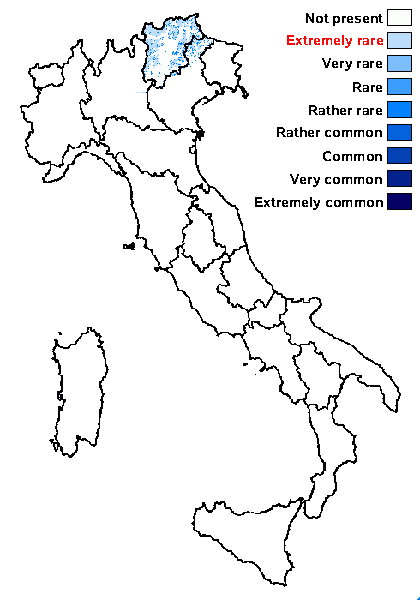Lecanoropsis pseudosarcopidoides (M. Brand & van den Boom) Ivanovich & Printzen
in Ivanovich & al., Phytotaxa, 695, 1: 38, 2025. Basionym: Lecanora pseudosarcopidoides M. Brand & van den Boom - in van den Boom & Brand, Lichenologist, 40: 475, 2008.
Synonyms:
Distribution: N - Ven (van den Boom & Brand 2008), TAA (van den Boom & Brand 2008, Ivanovich & al. 2025).
Description: Thallus crustose, endosubstratic to thinly episubstratic, continuous to faintly rimose-areolate, sometimes slightly warted, ecorticate, yellowish grey or pale to brownish grey, forming up to 4 cm wide patches, without a distinct prothallus. Apothecia lecanorine when young, later appearing biatorine, adpressed, broadly sessile to subglobose, 0.4-0.9 mm across, with an initially flat, later convex, pale pinkish to pale orange, pale to intense red-brown to dark brown or greyish, sometimes slightly pruinose disc and a thin, at first prominent and paler thalline margin tending to become of the same colour of the disc, and finally often excluded. Thalline exciple corticate only at base, the cortex 20-35 µm wide, the medulla at first rich in algae, but soon these limited to the basal part; epithecium colourless to yellowish brown, with many coarse, colourless granules, the darker spots N+ reddish violet; hymenium colourless, 40-50(-55) µm high, with orange-brown guttules; paraphyses simple or sparingly branched, 1.5-2 µm thick at mid-level, the apical cells not markedly swollen, to 3.5 µm wide; hypothecium 60-90 µm high, colourless to pale yellow. Asci 8-spored, clavate, very thin-walled, with a K/I+ blue, tall tholus penetrated by a faintly amyloid apical cushion, the wall K/I-, surrounded by a blue outer layer, Lecanora-type. Ascospores 1-celled (rarely 1-septate), hyaline, ellipsoid, 8.5-11.5 x 3.5-4.7(-5) µm. Micropycnidia immersed, greenish brown in upper part; microconidia simple to 1-septate, slightly curved, 5.3-7.4 x 1-1.3 µm. Mesopycnidia pale brown to blackish olive in upper part; mesoconidia bacilliform, slightly curved, 4.4.-6.3 x 1.4-2.2 µm. Leptopycnidia rare, often found at the margin of the hymenium; leptoconidia curved, 10-17 x 0.7-0.9 µm. Photobiont chlorococcoid. Spot tests: thallus and apothecia K-, C-, KC-, P-, UV-. Chemistry: isousnic acid. Note: a recently-described lignicolous species found on rotting trunks of conifers, mainly in the subalpine belt, in species-poor stands, often with Parmeliopsis ambigua. It is superficially similar to L. saligna, differing in the form of the conidia and in other minor morphological characters, and is certainly much more widespread in the Alps. For further details see van den Boom & Brand (2008) and Ivanovich & al. (2025).
Growth form: Crustose
Substrata: lignum
Photobiont: green algae other than Trentepohlia
Reproductive strategy: mainly sexual
Commonnes-rarity: (info)
Alpine belt: extremely rare
Subalpine belt: rather rare
Oromediterranean belt: absent
Montane belt: absent
Submediterranean belt: absent
Padanian area: absent
Humid submediterranean belt: absent
Humid mediterranean belt: absent
Dry mediterranean belt: absent

Predictive model
Growth form: Crustose
Substrata: lignum
Photobiont: green algae other than Trentepohlia
Reproductive strategy: mainly sexual
Commonnes-rarity: (info)
Alpine belt: extremely rare
Subalpine belt: rather rare
Oromediterranean belt: absent
Montane belt: absent
Submediterranean belt: absent
Padanian area: absent
Humid submediterranean belt: absent
Humid mediterranean belt: absent
Dry mediterranean belt: absent

Predictive model

